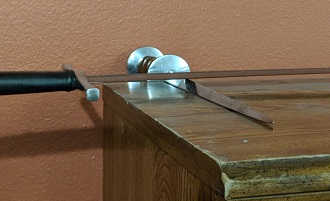
When describing a sword there are many different ways to quantify it. Simple ones we can easily grasp and understand. Weight? Check. Length? Check.
I’m going to try and break it down, with no math involved, what some of the other useful quantities associated with swords are. And if you know enough physics to nitpick the details, this wasn’t written for your benefit!
Balance Point
(aka Center of Mass, Center of Gravity)
Simply put, the point where the sword will balance. This is where the torque of the sword’s mass equalizes out. As most of you know, torque is force times distance, so a heavy pommel put closer to the balance point can ‘compensate’ for a lighter blade much further from the balance point. Though we will in the next section you can never make a sword rotate faster by adding weight.
This is fairly easy to test for: balance a sword on your finger. How is this useful in knowing about a sword? Quite simply: it isn’t really useful. It’s mainly made public because it’s an easy thing to measure. Significantly too far or too close to the crossguard will tell you something, but also know that someone can make two very different swords with a similar point of balance and weight.

Moment of Inertia
( aka Rotational Inertia, Mass Moment of Inertia )
This is a quantity that is actually closer to what you are looking for when you are asking about the point of balance. The Moment of Inertia* is a measure of how difficult it is to spin something. You can increase this in two ways:
1) Increasing the mass
You have more stuff, and it is hard to get that stuff spinning. We are halfway there, I assume you are still with me.
2) Moving the mass further from the rotation point
Imagine a stick with two weights hanging just off center.
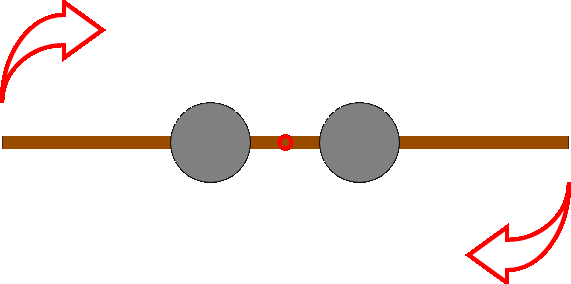
The point of balance for this stick is going to be right in the middle. Now move the weights out to the ends of the stick.
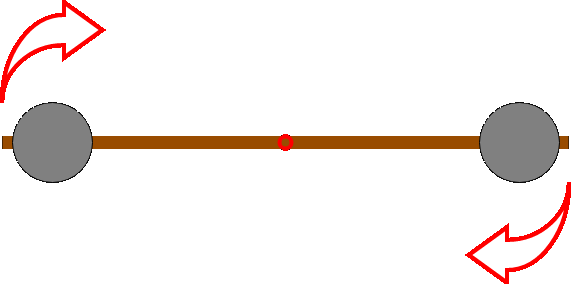
Where is the point of balance? Right in the middle, just the same as before. But even though the point of balance is the same and the weight is the same, it’s going to be much harder to swing this in a circle. (This is why figure skaters tuck their arms in when doing a spin and throw them out in order to slow down the rotation.)
The Moment of Inertia is a measurement which factors the mass distribution in, and will tell you how hard it is to get a blade rotating. Conversely it also tells you how hard it is for the target on the receiving end to get the blade to stop rotating into it.
In a little more colloquial terms, this gives you the effective ‘weight’ of the sword in rotation. Unfortunately because you can’t see the effect without a rotating blade, it’s a lot harder to measure.
*This is the Mass Moment of Inertia, as opposed to the Area Moment of Inertia, which would be a measurement involving the cross section of the sword and how stiff it is in bending.
Vibrational Node
(aka Node of Vibration or many other things)
The easy first think answer:
The place where the sword doesn’t vibrate when you hit it.
Strike any sword (on the flat preferably) and you will see it vibrate. There will be two points where it doesn’t. One will be roughly ⅔ of the way towards the tip of the sword. If the sword is well designed the other should sit where your hand is. (This helps vibrations not transmit through to your hand when you hit stuff.)
The more complicated answer:
If you take a sword and hold it rigidly in your hand(s), and push down on the tip, it will bend in a way that looks kind of like this:

Now if you instead put the point on the floor and push sideways on the blade (or just push straight down) it would look more like this:

This is because the point can no longer move, so the blade bends in a different way. Lets take it another step forward. Either put the sword in a vice, or stab it into something rigid enough that the tip can’t twist. (And you probably also need a vice-like grip on the handle to accomplish this.)

This is because neither the end in your hand nor the tip can twist, and the blade once again has to bend in a different way.
These are example of what are called Boundary Conditions, aka what the outside world is doing to your sword. If you hold it loosely and let it vibrate you are effectively offering no boundary conditions, just letting the sword vibrate in it’s natural state. If you were to grip a longsword tightly doing the vibration test you would change the boundary conditions, change the way the sword wants to bend, and hence change where the vibrational nodes end up!
Have the sword embedded in a target? Well that is going to have a much bigger effect. Enough so that the math is in the domain of people much more trained than I am.
Center of Percussion
Most of you probably ‘knew’ that the center of percussion is where the blade doesn’t vibrate when struck. But we are all now much more educated than we were 400 words ago, and know that is actually a Vibrational Node.
Some may not be convinced. If you need additional proof I can suggest:
- Consulting with someone who has formal training in physics/engineering
- Reading the somewhat convoluted descriptions of Center of Percussion on wikipedia or other physics sites
- Going into a university physics exam, solving for ‘the place where the object doesn’t vibrate’ when asked for the Center of Percussion, and having your teacher fail you.
Now that that’s out of the way. What is the center of percussion?
Imagine a pole which has been carefully and precisely balanced on end, sitting on a sheet of ice. It’s an art exhibition or something. Always conscious to give the fine arts the respect they deserve, you decide to throw a rock at it an knock it over.
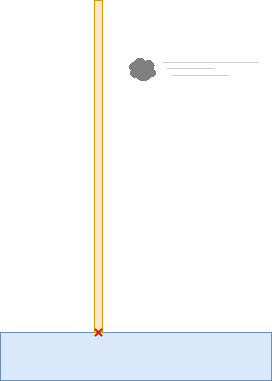
You would expect that as the rock hits the rod you would cause the end to to kick out. The Center of Percussion is the magic place where you can have the rock hit, have the pole knock over, and have the end not kick out.
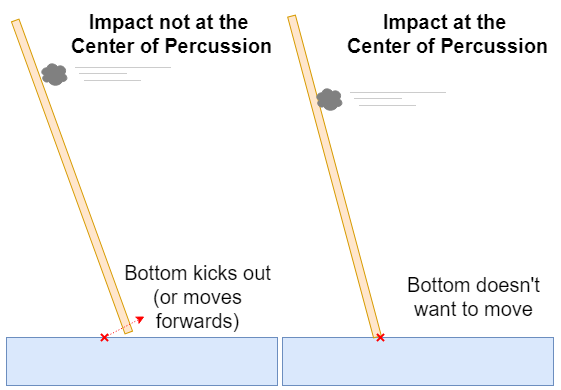
What does it mean from a swords perspective? If you hit something hard with your sword the tip is going to stop. If you hit at the Center of Percussion there is going to be no force transmitted back to your hand from the sword tip stopping.
But wait, there’s more!
Just like the Vibrational Node there is a little more grey area going on with the Center of Percussion. The sword isn’t floating in the air, it is connect to your hand, and if you are cutting with good mechanics, is connected through to the rest of your body. So it isn’t just a case of the sword alone, but at the same time it isn’t as simple as a rigid body, because no matter how awesome your last gym session was the flesh is still much softer than the steel.
So while the Center of Percussion of the sword can be determined through testing, that doesn’t mean it represents the final word in what actually happens when cutting. Same thing with the Vibrational Nodes, the sword in a target will not vibrate like it does in your light grip.
The physics for these become enormously complicated, and largely redundant since experienced cutters all have figured it out through testing. 🙂


So the CoP is related to the center of rotation, which can change, but for simplicity lets just call it where you grip the sword. When the sword is struck (or strikes) it acted upon by both a linear force and a moment as the sword attempts to turn about it’s center of mass. On the other side of the center of mass the moment acts opposite of the linear force.
It is difficult to explain without being able to draw a picture, but the center of rotation is where the moment and linear force cancel each other out. If the center of rotation lines up with your sword hand, you should barely (if at all) feel resistance on the cut. Shoot me an email if you want to talk about this a bit more.
Oh, I’ve seen plenty of those pictures in undergrad physics courses. 😀
One thing I’ve noticed in all the sword physics discussions I’ve ever read is things like assuming the CoR is at the hand. People who cut know very well that you want to keep the CoR in the center of your body, a long way from the sword. Additionally the idea of having no reaction force at the hand is probably not a very good one, hence the necessity of a strong grip. Because if there is no reaction force on the hand, then the body can conversely not use force to influence and re-enforce the strike.
But of course modeling this becomes that much more difficult. 😉